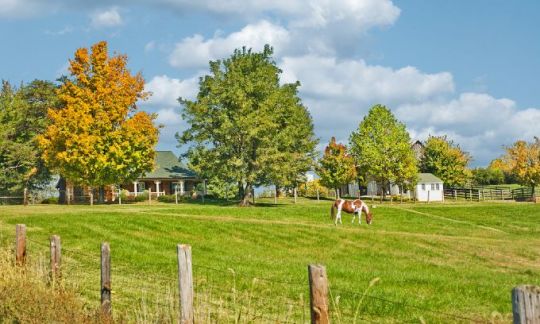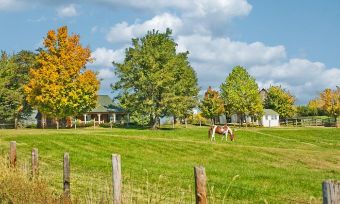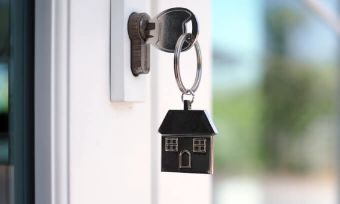Pros and cons of buying acreage
Is a ‘home among the gum trees’ right for you? We look at the upsides – and downsides – of buying acreage.

Is a ‘home among the gum trees’ right for you? We look at the upsides – and downsides – of buying acreage.
What is acreage?
Acreage refers to a large piece of land, often vacant land in a regional or rural location. The name refers to an acre; a unit of measurement comprising 4840 square yards, or around 4047 square metres. Despite the name, not every acreage is measured in acres—some are smaller, while others are much larger.
Pros of buying an acreage
Despite the sheer size of our country, Australia is highly urbanised. World Bank data shows 87% of us live in urban areas. City living may offer plenty of convenience, but for some of us, a home surrounded by generous open space, with lots of freedom to do your own thing is a personal goal. That’s when the advantages of acreage living can shine through. The benefits can include:
The potential for more privacy
Acreage blocks come in all shapes and sizes, from ‘hobby farms’ of less than 10 acres to far bigger spreads of 100 acres plus. What they all offer is a high level of privacy, simply because your neighbours are likely to be a lot further away compared to a typical suburban block.
The space to pursue hobbies
A key point of appeal of acreage is the space to play outside with kids or pets, or to pursue hobbies on your home turf that just wouldn’t be possible in the suburbs. From keeping a few horses or riding trail bikes, through to growing your own fruit and veggies on a grand scale, acreage can offer the scope to do it all.
Embracing the natural environment
Along with the potential for peace and quiet, you may be interested in buying acreage to reconnect with the natural environment. There’s no doubt an acreage property can be a haven for wildlife – anything from kangaroos to wombats and wallabies.
That said, this is Australia: not all wildlife is cute and cuddly. Your acreage could also be shared with snakes, and less welcome feral animals such as foxes.
Opportunities to build your dream home
If you are planning to build a new home, buying acreage can be a chance to have a home with a larger footprint than might be possible on a traditional block.
Of course, this will depend on local council building regulations, but lot sizes in capital cities in Australia have steadily decreased over the last 15 years. The Australian Bureau of Statistics says the average size of new lots for houses in capital cities was just 432 square metres as of 2022. By contrast, a one acre block is equal to about 4047 square metres, or 0.4 hectares, which can provide ample space to construct a residence of generous proportions.
Greater affordability
Buying acreage close to a major state capital can be a luxury buy that comes with a premium price tag. But if you’re prepared to look further out in regional Australia, where land values generally tend to be lower, the cost of acreage can be relatively affordable.
Cons of buying an acreage
While plenty of people who live on acreage relish being part of a non-urban landscape, it is not a lifestyle that will suit everyone. Some of the less attractive realities of buying acreage can include:
Increased maintenance
There is no getting around the fact that more land can often mean more work. Unless you choose to live on a ‘bush block’ with few alterations to the natural landscape, living on acreage can come with the additional time and costs such as:
- maintaining fencing
- keeping grass short (to minimise bushfire risk);controlling weeds
- potentially keeping water tanks clean and pumps in working order if your property does not have access to town water.
Fewer amenities
Suburban residents have access to a wealth of facilities that are not always available when you live on acreage. If you choose acreage in a regional area, for example, you may not be connected to town water or sewerage. Council garbage collection and even postal deliveries can be infrequent, and mobile phone connections can be patchy, with internet speeds often slower than in the city.
It’s worth noting that having fewer council services can make council rates much cheaper for regional acreage. The downside is that you could be visiting the local tip more often to get rid of garbage, or paying for potable water to be trucked to your home (which quickly becomes very expensive) during periods of drought when the water tanks run dry.
You may need a bigger buying deposit
If you need a home loan to buy acreage, the lender may require a larger deposit than for a suburban block. Lenders may believe that land is a higher financial risk than an established house, as it may prove harder to accurately value and sell if you were to default on your mortgage. You may want to shop around and compare your options, as different banks and mortgage lenders may have their own requirements and limitations around loans for acreage.
Home and contents cover could be more expensive
Acreage properties tend to have features that aren’t found in the average suburban home, like water tanks, vastly more fencing and gates, and perhaps a tractor or ride-on mower tucked away in one or more large sheds. In addition, acreage properties can come with a higher bushfire risk. These factors can all affect the premiums you may pay for home and contents insurance.
Depending on the size of your property, you could potentially be ineligible for a regular home and contents policy, and instead be directed towards a small or hobby farm policy.
The comparison rate for all home loans and loans secured against real property are based on secured credit of $150,000 and a term of 25 years.
^WARNING: This comparison rate is true only for the examples given and may not include all fees and charges. Different terms, fees or other loan amounts might result in a different comparison rate.

Up to $4,000 when you take out a IMB home loan. Minimum loan amounts and LVR restrictions apply. Offer available until further notice. See provider website for full details. Exclusions, terms and conditions apply.
 Owner occupied
Owner occupied
 20% min deposit
20% min deposit
 Redraw facility
Redraw facility
 Owner occupied
Owner occupied
 20% min deposit
20% min deposit
 Redraw facility
Redraw facility
 Owner occupied
Owner occupied
 10% min deposit
10% min deposit
 Redraw facility
Redraw facility
 Owner occupied
Owner occupied
 20% min deposit
20% min deposit
 Redraw facility
Redraw facility
Canstar may earn a fee for referrals from its website tables, and from Sponsorship or Promotion of certain products. Fees payable by product providers for referrals and Sponsorship or Promotion may vary between providers, website position, and revenue model. Sponsorship or Promotion fees may be higher than referral fees. Sponsored or Promoted products are clearly disclosed as such on website pages. They may appear in a number of areas of the website such as in comparison tables, on hub pages and in articles. Sponsored or Promoted products may be displayed in a fixed position in a table, regardless of the product’s rating, price or other attributes. The table position of a Sponsored or Promoted product does not indicate any ranking or rating by Canstar. For more information please see How We Get Paid.
Cover image source: Anne Kitzman/Shutterstock.com.
This article was reviewed by our Finance Editor Jessica Pridmore before it was updated, as part of our fact-checking process.

The comparison rate for all home loans and loans secured against real property are based on secured credit of $150,000 and a term of 25 years.
^WARNING: This comparison rate is true only for the examples given and may not include all fees and charges. Different terms, fees or other loan amounts might result in a different comparison rate.
 Owner occupied
Owner occupied
 20% min deposit
20% min deposit
 Redraw facility
Redraw facility
Try our Home Loans comparison tool to instantly compare Canstar expert rated options.
The comparison rate for all home loans and loans secured against real property are based on secured credit of $150,000 and a term of 25 years.
^WARNING: This comparison rate is true only for the examples given and may not include all fees and charges. Different terms, fees or other loan amounts might result in a different comparison rate.






